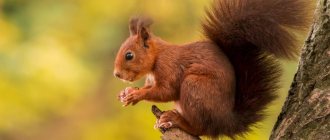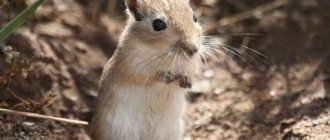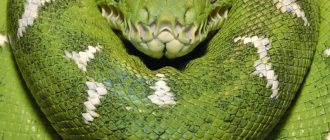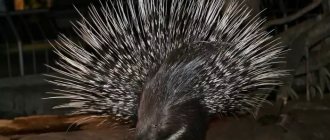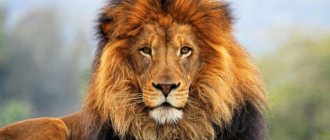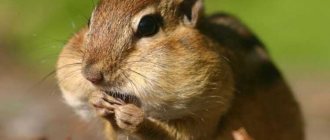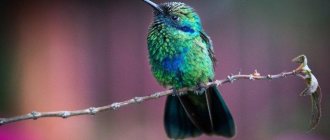- Wild animals
- >>
- Mammals
The marmot is a mammal that belongs to the order of rodents from the squirrel family. Representatives of the species weigh several kilograms and live in open spaces. Extremely social herbivores, wrapping themselves in warm fur and hiding in burrows from the hot steppes to the cold mountains. There are many classifications of these cute animals, which will be discussed further.
Description
— Advertising —
The smallest species (Menzbier's marmot, wood marmot) weigh at least 2-3 kg, their body length is 35-40 cm, the largest (steppe, Himalayan marmots) reach 8-10 kg in weight and 65-70 cm in length. The physique of marmots resembles squirrels and gophers. Their body is ridged and their legs are short. The head is flattened, the eyes are widely spaced, sometimes slightly slanted. The nose is large. The ears are short and round in shape. The tail is short and rounded. The fur is thick and long, with sparse guard hairs and soft undercoat. The color is plain or with a contrasting belly, cheeks and head. The coat ranges from yellowish-gray, silver-gray, brown, reddish-red to black.
Population and species status
The species is the woodchuck and is under protection. In the Red Book of Endangered Species it has already been assigned the status of a species of minimal risk . At the moment, the number of animals may increase. They benefit from the development of wild lands. Plowing, mining and clearing forests allows for the construction of additional burrows, and planting crops ensures uninterrupted feeding.
This is interesting! Marmots have a beneficial effect on the condition and composition of the soil. Tearing up the burrows helps to aerate it, and the feces serve as an excellent fertilizer. But, unfortunately, these animals can cause enormous damage to agricultural land by eating crops, especially when the colony is large.
Marmots are also hunted. Their fur is used to sew fur products. This activity is also considered entertaining due to the animal’s agility and its ability to quickly hide in holes. Their capture is also used for experiments on the processes of obesity, the formation of malignant tumors, as well as cerebrovascular and other diseases.
Return to content
What does it eat?
Marmots are herbivores and feed on green parts of plants. They look for food both on the ground and in trees. The composition of feed varies with seasons and habitats of species.
The diet of marmots includes leaves and flowers, forbs, and grain crops. Sometimes marmots eat snails, beetles, and grasshoppers. In early spring they feed on the bark, buds and shoots of apple, dogwood, bird cherry, peach, and red mulberry. Their favorite food is alfalfa and clover. Marmots also eat garden crops such as peas and beans. The diet in captivity consists of wild lettuce, clover, bluegrass and sweet clover. An adult marmot eats about 700 g of food per day. These animals do not stockpile food.
Human influence on species
Today, the number of the species is more stable, but in some areas it needs to be protected, as the steppes are plowed up and reforestation work is carried out. This was more noticeable in the 50s of the last century, because today they continue to re-acclimatize the bobak. The European subspecies reached a population of 210 thousand, and the Kazakh subspecies - 113. But this does not mean that the species has ceased to attract the attention of hunters, because fat is often used as medicine by traditional healers, and meat is edible and popular among the Mongols.
Common types of marmot
Gray marmot (Marmota baibacina)
The body length reaches 65 cm, the tail is about 13 cm long. Outwardly it resembles the boibak and tarbagan, but its fur is longer and softer, colored sandy-yellow, with black-brown hairs on the back, the belly is dark, reddish, and the head is dark "cap". The tail is colored on top in the same way as the back, and dark on the bottom.
The species is found in the Tien Shan and Altai mountains.
Baibak (Marmota bobak)
Body length is from 50 to 70 cm, maximum weight reaches 10 kg. The body is thick, the legs are short and strong with large claws. The head is large, flat, and the neck is short. The tail is short. The color is sandy yellow. The guard hairs have dark tips, which makes the back appear covered with dark brown or black ripples. The cheeks are light reddish in color, with brown or black streaks under the eyes. The belly is darker and redder towards the sides, the tip of the tail is dark brown. Molting occurs once a year.
Previously, boibak was found widely in the steppe and forest-steppe zones from Hungary to the Irtysh, but due to the plowing of virgin lands it disappeared almost everywhere, only populations survived on the Don, in the Middle Volga region, the southern Urals, in eastern Ukraine and Kazakhstan.
Gray marmot (Marmota caligata)
A large marmot with short legs and a wide head. The body length is 62-82 cm, with a tail length of 17 to 25 cm. Males are larger than females. Weight throughout the year ranges from 3.75 kg in May to 7 kg in September. The fur on the back and shoulders is silver-gray. The head is black on top with a white spot on the muzzle, on the chin and a white stripe around the lips. The legs are black below, occasionally with white spots. The belly is gray. The tail is long and covered with thick fur.
It lives in Canada and the USA, where it is found in treeless alpine meadows.
Black-capped marmot (Marmota camtschatica)
There are three subspecies: North Baikal, Leno-Kolyma and Kamchatka. Outwardly, they are similar to the Mongolian marmot tarbagan. They got their name because of their uniform brown color with a dark spot on the head, which from a distance looks like a cap.
The habitat includes Eastern and Northwestern Siberia.
Yellow-bellied marmot (Marmota flaviventris)
The body length of males is from 49 to 70 cm, in females from 47 to 67 cm. The weight of males is 3-5 kg, females 1.5-4 kg. The fur is gray-brown on the back and yellow-brown on the belly.
The species is distributed in the western USA and Canada, in the Sierra Nevada and the Rocky Mountains, at altitudes up to 2,000 m.
Himalayan marmot (Marmota himalayana)
It is dark chocolate brown with bright yellow spots on the face and chest.
It is found in the Deosai plains of Pakistan and Ladakh in Kashmir, at altitudes up to 3000 m.
Alpine marmot (Marmota marmota)
The body length is 40-50 cm, the tail length is 10-20 cm. Weight is about 3 kg. Males are usually larger than females. The head is blackish-gray, the muzzle is light. The ears are small and pubescent. The back is gray, light brown or red, the belly is yellowish.
The species lives in the Alps, Carpathians and High Tatras, on rocky slopes at altitudes from 600 to 3200 m.
Menzbier's marmot (Marmota menzbieri)
The smallest type. Body length is 40-45 cm, average weight reaches 2.5 kg. The distribution area is the western Tien Shan.
Woodchuck (Marmota monax)
Body length is from 42 to 67 cm, weight is 3-5 kg. Males are larger than females. The body is dense, the legs are short and strong. The tail is short, flat, bushy, black or dark brown. The ears are small and round in shape. The color is reddish or reddish-brown with a gray coating. There is a white spot near the nose. The belly is light. Paws are black.
A widespread species in the northeast and central states of the United States, central Alaska, and the Labrador Peninsula.
Mongolian marmot (Marmota sibirica)
Body length is about 60 cm. The species lives in Russia (in the steppes of Transbaikalia and Tuva), Mongolia (except for the southern regions), and in northeast China.
Olympic marmot (Marmota olympus)
A large species, the body weight of which reaches 7 kg.
Endemic to the Olympic Mountains, located in western Washington state in the northwestern United States.
Vancouver Marmot (Marmota vancouverensis)
Body length is 68-70 cm. Weight varies throughout the year from 3-3.5 kg to 5-6 kg. The fur also changes color with the seasons. At the beginning of summer it is brown, in July it moults and becomes black with white stripes.
Endemic to Vancouver Island in Canada, where it lives in mountains about 1.5 km high. An endangered species.
Range and habitat of boibak
The range of the boibak marmot (also called the steppe marmot) extends from Central Europe, through all of Russia to Central Asia. The species is most often found along the Don and Donets rivers, as well as in the mountains of the Middle and Southern Urals and in the steppes of Northern Kazakhstan. However, the current range is only a small part of the vast territory previously inhabited by the boibak.
Baibak usually lives in steppe ecosystems. It thrives in open, rolling meadows and along the edges of cultivated fields, preferring low mountain slopes and interfluves with a high density of shrubs and feather grasses. In areas where the steppes are partially plowed, marmots live on hard soil and fallow lands. Few animals dare to climb onto freshly plowed soil, since it provides few opportunities for building burrows and feeding. Sometimes rodents live along dirt roads running through the steppe.
Groundhog behavior
Marmots build burrows in dry areas that are well heated by the sun. Winter burrows are found in forests, summer burrows are found in open, flat areas, for example, in fields. Groundhog burrows have from 1 to 11 exits. The total length of the tunnels reaches 15 m. In a permanent burrow, the tunnels lead to the nesting chamber, which is lined with dry leaves and grass. Marmots also build special toilet chambers.
Marmots lead a solitary, sedentary lifestyle, only during the breeding season they live in pairs or groups. The period of activity of the groundhog is day, occasionally twilight and night.
By autumn, marmots eat off and accumulate fat. To hibernate, they migrate to wooded areas. Hibernation lasts from October to March-April. During thaws they may wake up briefly. During hibernation, metabolic processes decrease, the number of heartbeats is 10-15 beats per minute, body temperature is about 8 ° C, and the breathing rate decreases.
Marmots communicate with each other using a characteristic piercing whistle, heard at a distance of 200-300 m. While on the surface of the earth, they take a posture in a column. When threatened, they hide in a hole and move at speeds of up to 3 km/h.
Features of character and lifestyle
Baibaks, after emerging from hibernation, fatten up and begin to repair their burrows. The activity begins immediately at sunrise and ends only at sunset. The animals are very social: they post sentries while others feed. In cases of danger, they inform others about the impending threat, and everyone hides. Quite peaceful creatures that rarely fight.
Gray marmots are also diurnal creatures, known to feed on plants. Their colonies are very large and often exceed 30 individuals. Thus, this entire herd occupies 13-14 hectares of land and has a leader: an adult male marmot, 2-3 females and a large number of young marmots up to two years old. The burrows are simpler than those of bobaks and consist of one hole 1-2 meters deep. But their number exceeds a hundred.
Woodchucks are very careful and rarely move away from their burrows. Summer shelters are set up in well-lit areas. Winter burrows are hidden in forests on hillsides. Unlike gray marmots, forest marmots build a complex structure of burrows, which sometimes have more than 10 holes and 300 kg of discarded earth. They lead a sedentary, antisocial lifestyle.
The way of life depends more on the territory in which marmots live than the food they eat. Some live with females separately from each other, and some flock together in entire armies of 35 individuals. Some dig simple holes, while others plan intricacies, paying attention to emergency exits and restrooms.
Marmot Reproduction
Males emerge from hibernation first, and from the beginning of March to the end of April they search for females and engage in skirmishes with each other. Pregnancy lasts 31-32 days. The female brings from 2 to 7 cubs once a year. Babies are born in April-May, naked, deaf and blind, with a body weight of about 27 g and a length of up to 10 cm. In the second week of life, short black hair appears on the body. Milk feeding lasts about 44 days. Males do not breed offspring. At the age of 6-7 weeks, young marmots begin to disperse. They reach sexual maturity after the first hibernation.
The life expectancy of marmots in the wild is 4-6 years, in captivity up to 10 years.
Social structure and reproduction
At the beginning of spring, the mating season begins for boibaks. The duration of pregnancy is just over a month. 3-6 cubs are born. Newborns are very small and defenseless, so parents take care of them very carefully in the first stages of life. Females drive males into other burrows for the feeding period. At the end of spring, small bobwhites begin to feed on grass.
Female gray marmots give birth to 4 to 5 cubs a little later than boibaks - this event occurs in late spring or early summer. Pregnancy also lasts about a month. The children of gray-haired marmots are earlier and in the third week they already come to the surface, having fur and beginning to wean themselves from feeding with milk.
If female gray marmots allow males to help them during pregnancy, and female boibaks drive males into other burrows, then pregnant woodchucks are extremely aggressive and even members of their flock have to flee. It’s no wonder that the males immediately leave after conception, or rather drive them away.
Forest-steppe marmots are more loyal to each other and hibernate, even letting their neighbors into their burrows. Sometimes they do not interfere with uninvited guests in the form of badgers or other animals. The females of these friendly animals give birth to 4-5 cubs, and sometimes even 9!
Natural enemies
Marmots are hunted by wolves, pumas, lynxes, bears, mustelids, large birds of prey and snakes. In agricultural areas, large predators are rare, and marmots' main predators include foxes, coyotes, and dogs.
Marmot holes become a haven for many species of animals, snakes and birds; they are occupied by otters, chipmunks, gray voles, shrews, house mice, jerboas and white-footed hamsters. A rabbit, opossum, raccoon and skunk can easily spend the winter in the same burrow as a sleeping groundhog. Foxes also dig up and occupy marmot burrows.
Keeping a groundhog at home
Caring for marmots requires special care; wild animals by their nature are more demanding of their living conditions. To keep a domestic marmot, you need a cage with strong metal bars to avoid destruction from the sharp teeth of marmots.
The cage is divided into two spaces - the rodent's sleeping place and a latrine compartment. In the wild, marmots set up burrows in their burrows - specially designated places for emptying, thus such a latrine in the neighborhood will integrate the rodent into its usual way of life.
The groundhog will feed through a feeder attached to the walls of the cage. This is done in order to avoid an overturned bowl during a meal.
Marmots eat at least twice a day, but in the wild during the warm season, animals eat throughout the day in order to accumulate fat for future hibernation, thus overeating is not scary for the small animal. The home diet of marmots consists of: bread, corn flakes, bran, and raw vegetables and fruits.
Throughout their lives, rodents grow incisors, which must be ground down, which marmots can do on their own. The animals grind down their incisors with wooden twigs; if not properly cared for, this can lead to a distorted bite and starvation of the animal.
Strangers are prohibited from extending their hands to rodents, since due to the new unusual smell, the marmot becomes aggressive, perceiving the stranger as an object of danger, which can lead to injury to the person and will end in deep stress for the animal.
Interesting facts about the rodent:
- In the United States, Alaska has celebrated Groundhog Day on February 2 since 1886. On this day, according to the behavior of the groundhog, the duration of winter and the proximity of the arrival of spring are determined.
- Monuments to the marmot were erected in Angarsk, Aznakaevo and Karaganda.
- The Mongolian marmot is a carrier of the plague pathogen. In ancient times, it was consumed as food by the nomadic peoples of Central Asia, the Huns and the Mongols.
Offspring
The female carries the animals for about a month, after which several babies are born, which at first are not visible. The offspring appear around March, the female feeds the cubs with milk for 40 days, and they leave the parental home only the next year. It is curious that the females with their offspring and the male are in different burrows.
Marmot's relationship with other pets
The groundhog's relationship with pets is usually peaceful. Often, the behavior of animals depends on their character, so it is impossible to predict the future communication of two animals.
The inhabitants of the house are gradually accustomed to each other, monitoring the actions of the animals until the animals no longer show aggression during interaction. The groundhog, as a wild animal, may change in behavior during puberty, which can also affect the communication of animals in the house.
Colonial way of life
The family traditions of marmots, as incredible as it may seem, are very similar to human ones. Having once created a pair, the male and female remain marital fidelity for many years. Bringing a litter of 3-5 cubs once a year, they are not able to create a threat of overpopulation, but they themselves are constantly exposed to numerous dangers.
The hunt for the marmot is carried out hourly by a whole army of such dangerous and agile predators as cougars, wolves, coyotes, foxes, steppe ferrets, manulas, snakes, eagles, and golden eagles.
Humans also play an important role in the extermination of furry rodents, killing for their warm fur and tasty meat.
Commercial hunting for marmots is carried out with a gun or with birds of prey, but sometimes shooting is carried out for the sake of sport.
Placed in harsh survival conditions, marmot families look after their offspring with exceptional care. The mother feeds the cubs with milk for up to 50 days and keeps them with her at all times.
All adult individuals of the colony look after the young, without dividing them into “friends” and “strangers”. At the slightest danger, the sentinel gives a signal with a short whistle.
Despite their external clumsiness and imposing appearance, marmots are very mobile and, if necessary, can reach speeds of up to 16 km/h.
If we add to this their vigilance, speed of reaction and agility, then one can imagine how well prepared these creatures are for the fight for survival.
